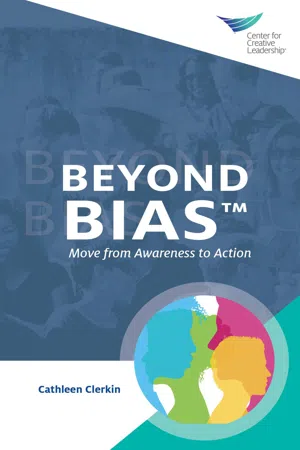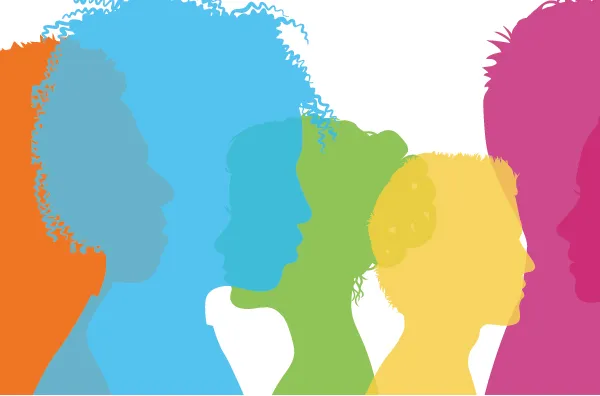
- 64 pages
- English
- ePUB (mobile friendly)
- Available on iOS & Android
eBook - ePub
Beyond Bias: Move from Awareness to Action
About this book
Understanding and working toward eliminating bias is an admirable goal for anyone, but especially for leaders. Leaders make decisions that change lives. They decide who is hired, promoted, or dismissed. They decide where to invest funds, when to bet on new ideas, and what the future of their organizations will be. Because of this, bias is a leadership liability.
Frequently asked questions
Yes, you can cancel anytime from the Subscription tab in your account settings on the Perlego website. Your subscription will stay active until the end of your current billing period. Learn how to cancel your subscription.
No, books cannot be downloaded as external files, such as PDFs, for use outside of Perlego. However, you can download books within the Perlego app for offline reading on mobile or tablet. Learn more here.
Perlego offers two plans: Essential and Complete
- Essential is ideal for learners and professionals who enjoy exploring a wide range of subjects. Access the Essential Library with 800,000+ trusted titles and best-sellers across business, personal growth, and the humanities. Includes unlimited reading time and Standard Read Aloud voice.
- Complete: Perfect for advanced learners and researchers needing full, unrestricted access. Unlock 1.4M+ books across hundreds of subjects, including academic and specialized titles. The Complete Plan also includes advanced features like Premium Read Aloud and Research Assistant.
We are an online textbook subscription service, where you can get access to an entire online library for less than the price of a single book per month. With over 1 million books across 1000+ topics, we’ve got you covered! Learn more here.
Look out for the read-aloud symbol on your next book to see if you can listen to it. The read-aloud tool reads text aloud for you, highlighting the text as it is being read. You can pause it, speed it up and slow it down. Learn more here.
Yes! You can use the Perlego app on both iOS or Android devices to read anytime, anywhere — even offline. Perfect for commutes or when you’re on the go.
Please note we cannot support devices running on iOS 13 and Android 7 or earlier. Learn more about using the app.
Please note we cannot support devices running on iOS 13 and Android 7 or earlier. Learn more about using the app.
Yes, you can access Beyond Bias: Move from Awareness to Action by Cathleen Clerkin in PDF and/or ePUB format, as well as other popular books in Negocios y empresa & Formación empresarial. We have over one million books available in our catalogue for you to explore.
Information

1
Why Addressing Bias is Essentialfor Leaders
Understanding and working toward eliminating bias is an admirable goal for anyone, but it is vital for leaders in particular. Leaders make decisions that change lives. They decide who is hired, promoted, or dismissed; where to invest funds, when to bet on new ideas, and what the future of their organizations will be. Because bias can shape assumptions about what certain people can do—often leading to inaccurate evaluations of both performance and potential—leaders who address bias are better able to fully leverage their teams.
Mitigating the effects of bias can also increase leaders’ ability to notice new trends, calculate risk, and read situations. This is because bias essentially relies on assumptions and over-generalizations. Such short-cuts often fail to recognize the full complexity of a given situation, leading to errors and faulty logic. Perhaps most importantly, unchecked bias among leaders can ripple through organizations, resulting in a climate where employees feel excluded, unvalued, and unsafe. In contrast, leaders who are savvy at noticing and addressing bias are more likely to be seen as inclusive leaders who are prepared to lead diverse groups.

UNDERSTANDING AND WORKING TOWARD ELIMINATING BIAS IS AN ADMIRABLE GOAL FOR ANYONE, BUT IT IS VITAL FOR LEADERS IN PARTICULAR. LEADERS MAKE DECISIONS THAT CHANGE LIVES. THEY DECIDE WHO IS HIRED, PROMOTED, OR DISMISSED; WHERE TO INVEST FUNDS, WHEN TO BET ON NEW IDEAS, AND WHAT THE FUTURE OF THEIR ORGANIZATIONS WILL BE.
While bias has always been an issue relevant to leadership, the connection has become hard to ignore in recent years. The quickly escalating globalization and diversification of the workforce, coupled with the increased social demand for justice, equity, diversity, and inclusion, has made understanding bias critical for anyone with leadership aspirations or responsibilities. This book will help leaders better understand what bias is, how you can recognize it, and what you can do about it.
TYPES OF BIAS
The word bias is tossed around a lot and is often used to mean many different things. Some scholars have argued the word “bias” has become so overused that it’s all but lost its meaning. For you to understand how to do something about bias in your life, it’s helpful first to explore how bias works and the different ways it can occur.
Theorists believe the word “bias” was first used in English in the 1600s as a technical term in the British game of bowls to describe a particular type of ball that was purposefully weighted on one side. These “biased” balls did not roll in a straight line but somewhat curved as they rolled. This serves as an excellent analogy for understanding bias today. A ball with an uneven distribution of weight might appear to be balanced at first glance, but it doesn’t play out that way. Instead, it has a hidden yet consistent preference for one side over another, making it challenging to aim true. But, over time and with practice, if you know the bias is there, you can learn to course correct.
Inspired by this concept, legal and statistical professions soon began using the word bias to describe circumstances that were not fair or accurate, but rather distorted or prejudiced, or “causing to incline to one side.”2 Soon, the term spread to social sciences, where the modern definition comes from: an intentional or unintentional preference for or against a specific group or individual.
In particular, scientists have heavily researched two types of psychological bias: cognitive bias and implicit associations. Typically, when people talk about bias, they are referring to one of these phenomena.
COGNITIVE BIAS
“Cognitive bias” refers to common mental shortcuts that are not entirely logical and rational. These mental tendencies are often a result of early socio-cultural learning or evolutionary preferences. Here are some examples of common cognitive biases:
Name of Bias | Definition |
Correspondence Bias | The tendency to assume that a person’s behaviors reflect their permanent disposition or personality, when such behaviors could actually be entirely explained by the situation. |
Confirmation Bias | The tendency to listen to and focus on information that confirms previously held beliefs. |
Hindsight Bias | The tendency to see events, even random ones, as predictable, leading to us looking back and believing that we “knew it all along.” |
Self-serving Bias | The tendency to give ourselves credit for successes but blame failures on causes outside ourselves or our control. |
Outcome Bias | The tendency to evaluate decisions based on their outcomes, not based on how the decision was made. |
In-group Bias | The tendency to favor others who belong to our own social group(s). |
Affinity Bias | The tendency to like others who are like ourselves. |
Status Quo Bias | The tendency to prefer the current state of affairs. |
Blind-spot Bias | The tendency not to notice our own biases. |
There are hundreds of cognitive biases, but these examples highlight the point: we make mental shortcuts all the time, often without realizing it, and thoughts or decisions we feel are logical and objective may be more biased and subjective than we realize.
REFLECTION
In looking at these nine common cognitive biases, can you think of a time when you might have fallen prey to these faulty ways of thinking? What was going on at the time? Were there specific circumstances that made you more prone to these biases? How might these biases impact your ability to lead effectively? Does your organization tend to rely on any of these biases? If so, how have they impacted organizational culture, decision making, or performance?
IMPLICIT ASSOCIATIONS
Another category of psychological bias is implicit associations. Implicit associations occur when our brains make connections between otherwise unassociated concepts (this is also sometimes called “implicit bias,” “implicit stereotypes,” or “implicit social cognition”).3 For example, in a classic study, researchers asked students to “draw a scientist” without giving them any further instructions. The most common image drawn was one of a man in a lab coat wearing glasses.4 This finding suggests that there is an implicit association between being a “scientist” and being a “man,” “wearing glasses,” and “wearing a lab coat”. Implicit associations are often made between certain groups or identities and their behaviors or abilities. However, implicit associations can also apply to other ideas or concepts as well.
A fundamental tenet of implicit associations is that we do not necessarily make these associations intentionally. Rather, implicit associations simply describe what associations are ‘wired’ into our brains through cultural norms. Indeed, many implicit association studies have found that people may explicitly state one belief (e.g., that all genders are equally good at science or that all races are equally smart) but that their implicit association scores reveal other associations they might not necessarily condone.
There has been some debate as to what this discrepancy suggests. For example, some have argued that implicit associations reveal the “truth” as to whether people are racist, sexist, etc. Others have argued that implicit associations are faulty measures because they don’t always align with the beliefs people explicitly endorse. However, leaders in the field urge us not to jump to either of these conclusions. Rather, implicit associations are just what they claim to be: a measure of the extent to which our brain associates different concepts. This doesn’t necessarily reflect our morals or explicit beliefs, but merely how our brains have connected pieces of information it has encountered out in the world. As such, it is a better measure of social and cultural norms than personal values. At the same time, implicit bias can play a role in how we treat people and process information, so understanding and acknowledging our implicit associations can help us determine what we need to do to make sure that our impact match our intentions.
TEST YOUR...
Table of contents
- Cover
- Title Page
- Copyright
- Contents
- Introduction: What is Bias?
- Part 1: Why Addressing Bias is Essential for Leaders
- Part 2: The Beyond Bias Model
- Part 3: Challenging the Habit of Bias — the Script™ Toolkit
- Bibliography
- About the Center for Creative Leadership